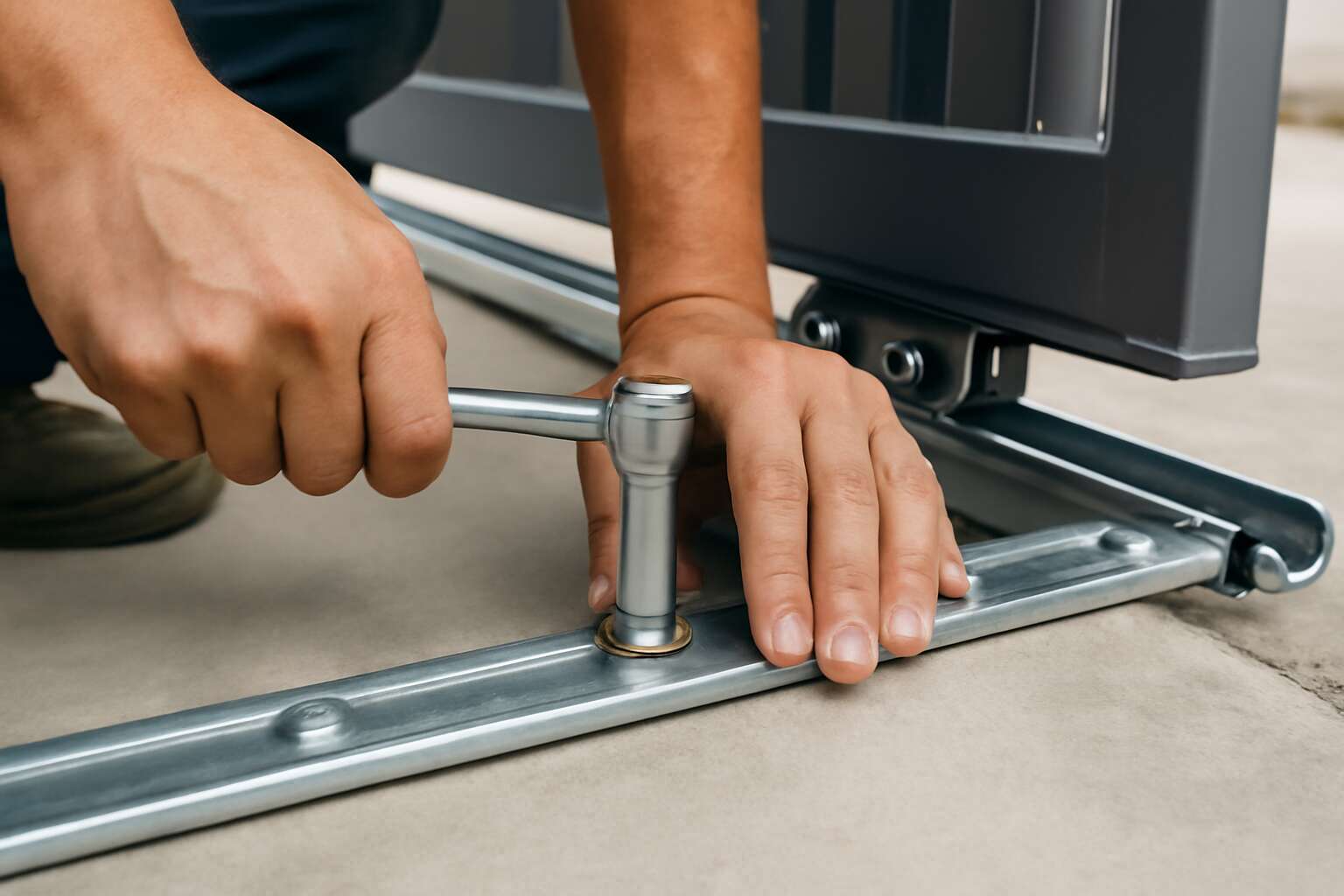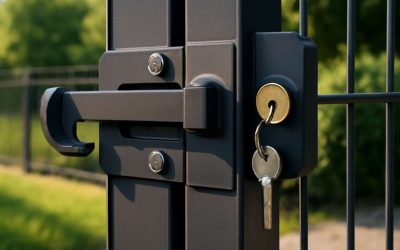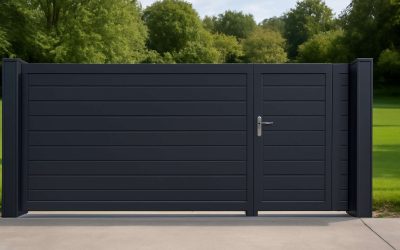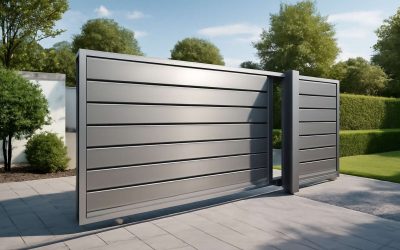Understanding Sliding Gate Tracks
What Is a Sliding Gate Track?
In the grand tapestry of modern security solutions, the sliding gate track installation stands as an essential thread—an unassuming yet indispensable element that holds the promise of seamless elegance and formidable strength. Imagine a mechanism so refined that it whispers the promise of effortless access, yet bears the resilience to withstand South Africa’s diverse climate and rugged terrain. The sliding gate track is the unseen hero, guiding the gate with unwavering precision and grace.
What exactly is a sliding gate track? At its core, it is the sturdy pathway upon which your gate glides, transforming a simple barrier into a fluid, almost magical, passageway. Crafted from durable materials like galvanised steel or aluminium, these tracks are designed to endure the tests of time and weather. Proper sliding gate track installation is vital to ensure your gate opens smoothly, quietly, and securely—traits that turn everyday access into an experience of effortless control.
When considering sliding gate track installation, it’s crucial to understand the components involved. These include:
- The track itself—carefully aligned and anchored to the ground, ensuring stability and longevity.
- The rollers or wheels—facilitating the gate’s glide along the track with minimal resistance.
- The mounting hardware—secured meticulously to withstand frequent use and environmental wear.
Each element plays a vital role in creating a reliable, long-lasting sliding gate system that elevates the security and aesthetic appeal of your property. Whether for a grand estate or a bustling commercial hub, the mastery of sliding gate track installation ensures that the gateway to your world remains both majestic and resilient.
Types of Sliding Gate Tracks
When delving into the realm of sliding gate track installation, understanding the types of tracks available is crucial—after all, not all tracks are created equal, nor do they serve the same purpose. South African terrain demands a tailored approach, selecting a track that can withstand both the blistering sun and the frequent downpours. The most common varieties include flat-bottom, u-channel, and flange tracks, each with its own set of advantages and ideal applications.
Flat-bottom tracks are often favored for their sleek appearance and ease of installation, making them perfect for residential properties aiming for subtle elegance. U-channel tracks, on the other hand, offer added stability, especially useful in areas with uneven ground or high wind conditions. Flanged tracks are robust, designed to handle heavy gates, and are typically employed in commercial environments where durability is non-negotiable.
Choosing the right type of sliding gate track is akin to selecting the perfect pair of shoes—fit for purpose and tailored to the terrain. This decision influences the longevity of your sliding gate system and the smoothness of its operation, turning a mundane task into an effortless glide along a meticulously installed track.
Benefits of Using a Sliding Gate Track
In the shadowed corridors of security, a sliding gate track becomes more than just a mere fixture; it transforms into the silent guardian of your domain. The benefits of using a sliding gate track for installation extend far beyond aesthetics. It offers a seamless, whisper-quiet operation that feels almost supernatural—an effortless glide that belies the craftsmanship beneath. With the right track in place, your gate becomes an extension of your fortress, resilient against the relentless South African elements.
Choosing to invest in proper sliding gate track installation ensures durability and longevity. It’s not merely about mounting a gate; it’s about forging a barrier that withstands the test of time and weather. The right track diminishes wear and tear, reduces operational noise, and minimizes maintenance — turning what might seem mundane into an act of dark poetry, a ballet of steel and precision. In this dance of metal and earth, every element matters, and the track is the unsung hero guiding your gate’s eternal march.
Preparing for Sliding Gate Track Installation
Assessing Your Gate Needs
Almost 70% of property owners underestimate the importance of thorough preparation before diving into sliding gate track installation. Skipping this step can turn your sleek entrance into a stumbling block—literally! Before you grab your tools and start measuring, take a moment to assess your gate needs. Is your property sprawling or cozy? Heavy-duty or just for show? Clarifying these details ensures you choose the right sliding gate track and avoid costly mistakes later on.
During this phase, consider factors like ground levelness, available space, and terrain. A level surface is crucial because an uneven track can cause your gate to stick or derail—nobody wants that. For a smooth operation, it’s essential to evaluate the surrounding environment. This includes checking for obstructions, slope, and soil stability. If you’re unsure whether your setup is optimal, a quick consultation with a professional can save headaches down the line.
To streamline your planning, you might find it helpful to create a simple checklist:
- Measure the width and height of your gate accurately
- Assess the ground surface for levelness and stability
- Identify potential obstacles that could interfere with track installation
- Determine the type of sliding gate track best suited for your needs
Choosing the Right Track Material
Choosing the right track material is a pivotal step in ensuring a successful sliding gate track installation. The durability of your gate depends heavily on selecting a track that can withstand South Africa’s diverse climate and terrain. Steel is a popular choice due to its strength and longevity, especially in areas prone to harsh weather. Aluminum, on the other hand, offers a lightweight alternative that resists rust, making it ideal for coastal regions where salt corrosion is a concern.
When considering track options, evaluate the terrain and ground stability. For uneven or soft ground, a reinforced or specialized track might be necessary to prevent derailment or sagging. It’s also worth noting that the type of sliding gate track you choose should align with your gate’s weight and frequency of use. A heavy-duty track may cost more upfront but can save you from costly repairs and replacements down the line. Ultimately, investing in the right material ensures smooth operation and long-term reliability of your sliding gate.
Tools and Materials Required
Embarking on sliding gate track installation is a bit like preparing to host a grand feast — you need the right tools, a dash of patience, and an understanding of the process to avoid ending up with a gate that’s more “swing and a miss” than a smooth glide. According to industry experts, the quality of your tools directly influences the longevity and performance of your gate, so skimping here is a rookie mistake.
Before you start, gather your arsenal: a drill, measuring tape, level, concrete mixer (if you’re pouring a new foundation), and safety gear — because nothing kills the mood faster than a rogue flying bolt! For securing the track, you’ll need durable fasteners like anchors and bolts tailored to the material you’ve chosen. Proper preparation ensures your sliding gate track installation is seamless, preventing future headaches and costly repairs. A well-prepared setup is the secret sauce to a reliably smooth sliding operation, especially in South Africa’s diverse climate.
Step-by-Step Guide to Installing a Sliding Gate Track
Measuring and Marking the Installation Area
In rural South Africa, where every second counts and safety is paramount, proper sliding gate track installation can transform the way you manage your property. Before you begin, take a moment to carefully measure and mark the installation area—this step is crucial for ensuring your gate operates smoothly for years to come. Accuracy here prevents costly adjustments later and guarantees that your gate glides effortlessly along its track.
Start by clearing the designated space and using a measuring tape to determine the length needed for your sliding gate track. Mark the precise position of the track with a chalk line or marker, ensuring it runs perfectly straight and level. When marking, consider the gate’s weight and size, as these factors influence the depth and type of track required. A well-marked installation area lays the foundation for a seamless sliding gate experience, blending durability with effortless operation. Remember, taking the time to measure and mark meticulously can save you frustration and time during the actual sliding gate track installation process.
Preparing the Ground Surface
Preparing the ground surface for sliding gate track installation demands meticulous attention, for it is here that the foundation of effortless operation is laid. The terrain must be rendered flat and stable, eradicating any undulations or debris that could compromise the smooth glide of your gate. A level surface not only enhances the durability of the sliding gate track but also reduces wear and tear over time, ensuring longevity and reliability.
In this phase, the ground is often excavated to a specified depth, tailored to the weight and size of the gate. This excavation creates a trench that accommodates the track, providing a solid base for secure anchoring. For added stability, consider the inclusion of crushed stone or gravel—materials that promote drainage and prevent shifting or settling.
To streamline the process of sliding gate track installation, some professionals prefer to use a simple yet effective approach:
- Clear the installation site of all debris and vegetation.
- Use a measuring tape and a level to mark out the exact pathway where the track will run, ensuring it aligns perfectly with the gate’s intended movement.
- Excavate the marked area to the appropriate depth, based on the track’s specifications.
- Fill the trench with a compacted layer of gravel or concrete, creating a firm, level bed.
This detailed groundwork not only guarantees that the sliding gate track installation proceeds smoothly but also cultivates a foundation resilient enough to withstand South Africa’s diverse climate conditions. A well-prepared surface is, after all, the silent guarantor of a gate that opens and closes with effortless grace, year after year.
Installing the Track Posts
Securing your property with a sliding gate begins with the crucial step of installing sturdy track posts. In South Africa’s diverse climate, a well-executed sliding gate track installation can mean the difference between smooth operation and constant maintenance headaches. It’s a process that demands patience and precision, but the reward is a gate that moves effortlessly through every season.
Start by positioning the track posts at each end of the designated pathway, ensuring they are perfectly aligned with the gate’s intended motion. Use a level to verify that each post is plumb, as even the slightest tilt can hinder smooth sliding. Once aligned, mark the post locations securely in the ground, double-checking measurements to prevent future misalignment.
Next, anchor the posts into the ground with concrete, allowing ample curing time. This firm foundation stabilizes the entire sliding gate track installation, safeguarding against shifting or sagging over time. For added durability, some professionals recommend embedding metal sleeves within the concrete, especially in areas prone to moisture or shifting soil. Whether you’re working on a rural homestead or a bustling residential estate, these steps ensure your sliding gate remains reliable for years to come.
Laying and Securing the Track
Embarking on a sliding gate track installation might seem straightforward, but a few crucial steps can make or break the entire process. The secret to a seamless glide? Properly laying and securing the track—think of it as giving your gate the smooth highway it deserves. First, ensure the ground surface is impeccably prepared; a wobbling track is the bane of any sliding gate’s existence. Once the surface is ready, position the track carefully, making sure it’s perfectly aligned with the pathway. This alignment is vital for the gate to move effortlessly without jamming or derailing.
Next, securing the track involves more than just a few whacks with a hammer. For durability, use appropriate fasteners and ensure the track is firmly anchored into the ground. For added stability, some professionals recommend embedding the track in concrete or fixing it with steel anchors, especially in areas prone to soil shifting. Remember, a well-executed sliding gate track installation ensures your gate opens and closes like a charm—reliable, smooth, and maintenance-free for years to come.
Mounting the Gate Rollers
Mounting the gate rollers is the moment where your craftsmanship truly shines—or falters, if you’re not paying attention! This step is crucial in the sliding gate track installation process because properly installed rollers ensure your gate glides smoothly, like a figure skater on ice—minus the fancy spins, of course. First, position the rollers on the designated bracket or track hanger, making sure they’re aligned precisely with the track you laid earlier.
Once in place, it’s time to secure them firmly. Most professionals recommend tightening the roller bolts just enough to allow smooth movement without excessive play. To keep everything in tip-top shape, double-check that the rollers are level and free of debris—no one wants a jamming gate! If your gate is particularly hefty or your terrain isn’t exactly flat, consider using steel anchors or embedding the rollers in concrete for added stability. Remember, the goal is a seamless glide from start to finish, so take your time during this step in the sliding gate track installation process—precision now pays off with years of hassle-free operation.
Final Adjustments and Testing
Once the track is securely in place and the rollers are mounted, the final adjustments are where the true craftsmanship unfolds. This stage transforms a functional installation into a masterpiece of precision and grace. Carefully test the gate’s movement along the sliding gate track, observing its glide and noting any resistance or misalignment. It’s a delicate dance—each tweak bringing the gate closer to perfection.
To ensure seamless operation, make these adjustments:
- Loosen or tighten the roller bolts incrementally, allowing for smooth movement without excessive play.
- Check that the gate remains level and aligned with the track, correcting as necessary.
- Inspect the entire length of the track for debris or obstructions that could impede motion.
Perform multiple tests—opening and closing the gate slowly at first, then with increased speed—to confirm stability. When the gate glides effortlessly, and the track remains pristine, you’ll know the sliding gate track installation has been executed with finesse. This meticulous final step ensures years of reliable, hassle-free operation, reflecting a true devotion to quality craftsmanship.
Tips for a Successful Sliding Gate Track Installation
Common Mistakes to Avoid
In the delicate dance of sliding gate track installation, precision is paramount—yet, even seasoned artisans can stumble into pitfalls that compromise the entire endeavor. A common mistake involves neglecting proper ground leveling; an uneven surface can cause the gate to derail or jam, disrupting the fluidity of its operation. Ensuring a perfectly flat and stable foundation is essential for smooth sliding action and long-term durability.
Another often overlooked aspect is the alignment of the track. Misaligned tracks not only strain the rollers but also accelerate wear and tear. Take the time to double-check measurements and ensure the track runs perfectly parallel to the gate’s path. Remember, a small deviation at the start can cascade into significant issues later on.
- Failing to secure the track firmly to the ground, resulting in movement under heavy use.
- Overlooking weatherproofing measures, which can lead to rust and degradation over time.
By avoiding these common mistakes, the process of sliding gate track installation becomes less daunting and more of an art form—merging precision, patience, and a dash of craftsmanship into a seamless experience that elevates your property’s elegance and security.
Ensuring Proper Alignment
Achieving flawless sliding gate track installation is less about luck and more about meticulous attention to detail. Proper alignment is the secret ingredient that transforms a clunky, noisy gate into a sleek, effortless marvel. When the track isn’t perfectly parallel to the gate’s path, even the most robust rollers can become strained, leading to premature wear and tear. That’s why patience—paired with a keen eye—is essential in this process.
To ensure optimal performance, take the time to double-check measurements and use a spirit level or laser guide for precision. Remember, a tiny misalignment at the outset can snowball into significant issues down the line. For added assurance, consider employing a simple
- string line or chalk line
to keep your track perfectly aligned during installation. These tools are understated heroes in the quest for seamless sliding gate track installation, helping you avoid costly rework and frustration.
Ultimately, a properly aligned track not only guarantees smooth operation but also extends the longevity of your gate mechanism—proof that in the art of sliding gate track installation, precision is indeed power. Once aligned correctly, securing the track firmly to a stable ground surface is the next step in creating a durable, reliable sliding gate system that stands the test of time and weather.
Maintenance Tips for Longevity
Maintaining your sliding gate track installation isn’t just about initial setup; it’s about preserving the system’s efficiency and longevity over time. Regular maintenance helps prevent costly repairs and keeps your gate functioning smoothly, especially in South Africa’s varied climate. Simple routines, like lubricating rollers and checking for debris, can make a significant difference.
To ensure your sliding gate track remains in top condition, consider implementing a few key practices. For example, inspecting the track for signs of wear or misalignment allows you to address issues before they escalate. Additionally, keeping the track clean from dirt and obstructions ensures unobstructed movement. A well-maintained track not only improves operation but also extends the lifespan of the entire sliding gate system.
- Schedule regular inspections—at least quarterly—to catch early signs of wear.
- Use a high-quality lubricant suitable for outdoor conditions to reduce friction and prevent rust.
- Clear away any debris, leaves, or mud that could hinder smooth operation.
Investing in proper maintenance techniques for your sliding gate track installation ensures it remains resilient against South Africa’s weather and heavy usage. This proactive approach saves money and stress in the long run, proving that routine care is as vital as the initial installation process.
When to Seek Professional Help
Complex Installations
When dealing with the intricacies of sliding gate track installation, recognizing when to seek professional help can be the difference between a seamless operation and a costly misstep. Complex installations, especially those involving uneven terrain or intricate gate mechanisms, demand a level of expertise that goes beyond basic DIY skills. If your property features a slope, uneven ground, or if you’re working with custom gate designs, it’s wise to bring in seasoned specialists.
Attempting to handle complex sliding gate track installation without proper experience can lead to misalignment, uneven weight distribution, or even structural failure over time. For those facing challenging environments, consulting professionals ensures that the installation adheres to safety standards and functions smoothly for years to come. Remember, precision in measuring, leveling, and anchoring the track often requires specialized tools and knowledge—investing in expert assistance guarantees longevity and optimal performance.
Structural Challenges
Within the realm of sliding gate track installation, there lurks a hidden threshold—one that separates the realm of effortless automation from the chaos of structural failure. When your property presents **structural challenges** such as a steep incline, uneven ground, or an irregular terrain, the call for professional help becomes undeniable. These obstacles demand more than simple measurements; they require a mastery of terrain adaptation and precision alignment that only seasoned specialists possess.
Attempting to navigate these complexities without expert guidance often results in misalignment, uneven weight distribution, and ultimately, a compromised gate system. For properties with uneven terrain or custom gate designs, engaging professionals ensures your sliding gate track installation is executed with unwavering accuracy. Specialized tools and extensive experience are vital to overcoming these hurdles, transforming a challenging landscape into a seamless gateway that withstands the test of time. Remember, when the ground refuses to cooperate, professional intervention is not just advisable—it’s essential for a flawless, durable installation.
Safety and Compliance Considerations
When the terrain whispers of hidden perils—such as unstable ground, significant inclines, or unpredictable surface irregularities—seeking professional help for sliding gate track installation becomes an imperative. These challenging conditions are not merely obstacles; they are gateways to potential failure if approached without expert guidance. Attempting to tackle such complexities alone can lead to misalignment, uneven weight distribution, and ultimately, a compromised gate system that may falter over time.
Safety and compliance are the pillars of a successful sliding gate track installation, especially when dealing with unpredictable landscapes. Engaging seasoned specialists ensures adherence to local regulations and safety standards, safeguarding property and loved ones alike. This is particularly crucial in South Africa, where terrain diversity demands meticulous attention to detail. When in doubt, remember that professional intervention is not just advisable—it’s essential for a flawless, durable installation that stands the test of time and nature’s whims.




0 Comments